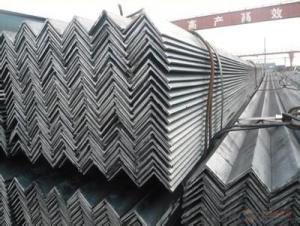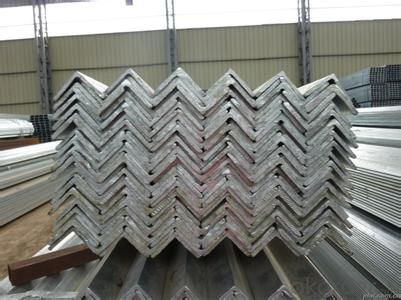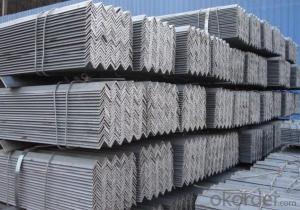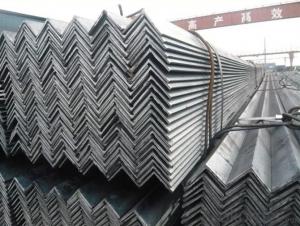High Quality Hot Rolled Angle Steel GB Q235
- Loading Port:
- Tianjin
- Payment Terms:
- TT or LC
- Min Order Qty:
- 25 m.t.
- Supply Capability:
- 20000000 m.t./month
OKorder Service Pledge
OKorder Financial Service
You Might Also Like
Product Description:
OKorder is offering high quality High Quality Hot Rolled Angle Steel GB Q235at great prices with worldwide shipping. Our supplier is a world-class manufacturer of steel, with our products utilized the world over. OKorder annually supplies products to European, North American and Asian markets. We provide quotations within 24 hours of receiving an inquiry and guarantee competitive prices.
Product Applications:
According to the needs of different structures, Angle can compose to different force support component, and also can be the connections between components. It is widely used in various building structures and engineering structures such as roof beams, bridges, transmission towers, hoisting machinery and transport machinery, ships, industrial furnaces, reaction tower, container frame and warehouse etc
Product Advantages:
OKorder's High Quality Hot Rolled Angle Steel GB Q235 durable, strong, and resist corrosion.
Main Product Features:
· Premium quality
· Prompt delivery & seaworthy packing (30 days after receiving deposit)
· Corrosion resistance
· Can be recycled and reused
· Mill test certification
· Professional Service
· Competitive pricing
Product Specifications:
Manufacture: Hot rolled
Grade: Q195 – 235
Certificates: ISO, SGS, BV, CIQ
Length: 6m – 12m, as per customer request
Packaging: Export packing, nude packing, bundled
Sizes: 25mm-250mm | ||||||||||||
a*t | ||||||||||||
25*2.5-4.0 | 70*6.0-9.0 | 130*9.0-15 | ||||||||||
30*2.5-6.6 | 75*6.0-9.0 | 140*10-14 | ||||||||||
36*3.0-5.0 | 80*5.0-10 | 150*10-20 | ||||||||||
38*2.3-6.0 | 90*7.0-10 | 160*10-16 | ||||||||||
40*3.0-5.0 | 100*6.0-12 | 175*12-15 | ||||||||||
45*4.0-6.0 | 110*8.0-10 | 180*12-18 | ||||||||||
50*4.0-6.0 | 120*6.0-15 | 200*14-25 | ||||||||||
60*4.0-8.0 | 125*8.0-14 | 250*25 | ||||||||||
FAQ:
Q1 How do we guarantee the quality of our products?
A1 We have established an advanced quality management system which conducts strict quality tests at every step, from raw materials to the final product. At the same time, we provide extensive follow-up service assurances as required.
Q2 How soon can we receive the product after purchase?
A2 Within three days of placing an order, we will begin production. The specific shipping date is dependent upon international and government factors, but is typically 7 to 10 workdays.
Q3 What makes stainless steel stainless?
A3 Stainless steel must contain at least 10.5 % chromium. It is this element that reacts with the oxygen in the air to form a complex chrome-oxide surface layer that is invisible but strong enough to prevent further oxygen from "staining" (rusting) the surface. Higher levels of chromium and the addition of other alloying elements such as nickel and molybdenum enhance this surface layer and improve the corrosion resistance of the stainless material.
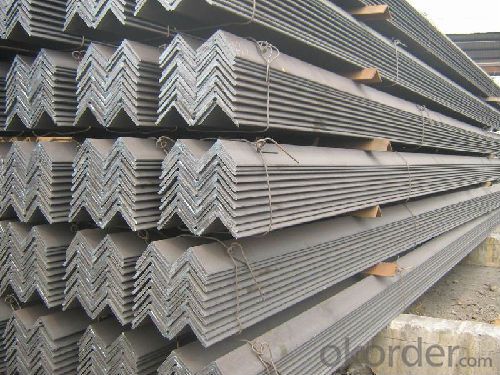
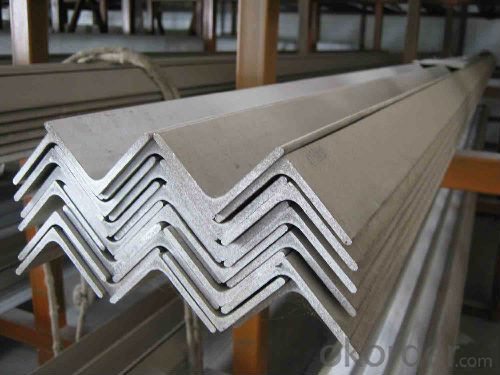
- Q: Can steel angles be used for bracing purposes?
- Yes, steel angles can be used for bracing purposes. Steel angles are commonly used as structural components in construction due to their strength and durability. They are often used to provide additional support and stability to various structures, including buildings, bridges, and industrial equipment. Steel angles can be easily bolted or welded to the main framework of a structure, providing additional rigidity and resisting forces such as compression, tension, and lateral loads. Their versatile shape allows for a wide range of bracing applications, making them a popular choice for bracing purposes in construction and engineering projects.
- Q: Can steel angles be used in telecommunications or broadcasting structures?
- Yes, steel angles can certainly be used in telecommunications or broadcasting structures. Steel angles provide structural support and stability, making them ideal for constructing towers, antennas, and other infrastructure required for telecommunications and broadcasting purposes.
- Q: Can steel angles be used in the construction of power plants?
- Yes, steel angles can be used in the construction of power plants. They provide structural support and stability, making them suitable for various applications such as framing, bracing, and supporting equipment and machinery in power plants.
- Q: What are the different grades of steel used for manufacturing steel angles?
- The different grades of steel used for manufacturing steel angles include A36, A572, A588, and A992.
- Q: Can steel angles be drilled or punched for fastening?
- Yes, steel angles can be drilled or punched for fastening. Steel angles are commonly used in construction and manufacturing industries for their structural strength and versatility. When it comes to attaching steel angles to other materials or fastening them together, drilling or punching holes is a common method. Drilling is the process of creating holes in steel angles using a drill bit. This allows for precise placement of holes and is suitable for applications where the angle needs to be attached to a specific location. Drilling can be done manually or with the help of drilling machines, depending on the scale of the project. Punching, on the other hand, involves using a punch and die set to create holes in steel angles. This method is faster and more efficient than drilling, especially when dealing with large quantities of angles. Punching machines can create holes of various sizes and shapes, making it suitable for different fastening requirements. Once the holes are drilled or punched, fastening can be done using bolts, screws, or rivets. These fasteners are inserted through the holes and tightened to securely hold the steel angles together or attach them to other materials. The choice of fastening method depends on the specific application and load requirements. In summary, steel angles can indeed be drilled or punched for fastening. Whether it's for attaching steel angles to other materials or joining them together, drilling or punching holes provides the necessary means for secure and reliable fastening in various construction and manufacturing projects.
- Q: Are steel angles suitable for supporting heavy machinery?
- Indeed, steel angles possess the necessary attributes to effectively support heavy machinery. Boasting strength, durability, and an elevated load-bearing capacity, these angles emerge as a prime selection for bolstering heavy machinery. Their prevalence in both industrial settings and construction ventures is a testament to their ability to furnish structural support. By either employing bolts or welding techniques, one can seamlessly amalgamate these angles, yielding a robust framework capable of withstanding the weight and vibrations engendered by heavy machinery. Moreover, the versatility of steel angles permits customization, facilitating the development of resilient and dependable support structures tailored to meet specific requirements posed by heavy machinery.
- Q: How do steel angles contribute to the overall strength of a structure?
- Steel angles contribute to the overall strength of a structure in several ways. First and foremost, they provide structural stability by distributing the load and forces evenly throughout the structure. The L-shape of steel angles allows them to resist bending and twisting, making them ideal for providing support and preventing deformation. Steel angles are often used as bracing elements in construction due to their high strength-to-weight ratio. By adding diagonal steel angles to a structure, it becomes more resistant to lateral forces such as wind or seismic loads. These angles help to transfer the applied forces to the foundation, reducing the risk of structural failure. Another way steel angles contribute to strength is by providing additional reinforcement. They can be strategically placed at critical points of a structure, such as corners or joints, to enhance its overall rigidity and durability. Steel angles can also be used as framing members, supporting beams, or columns, further enhancing the load-bearing capacity of the structure. Moreover, steel angles are resistant to corrosion and have a long lifespan, making them a reliable choice for structural applications. They can withstand harsh environmental conditions, ensuring the structural integrity of the building over time. Overall, steel angles play a crucial role in enhancing the strength and stability of a structure. Their ability to distribute loads, resist bending and twisting, provide reinforcement, and withstand environmental factors make them an essential component in modern construction.
- Q: What are the different types of steel angles connections for mezzanine floors?
- There are several types of steel angle connections commonly used for mezzanine floors, including bolted connections, welded connections, and clip angle connections. Bolted connections involve using bolts and nuts to secure the steel angles together. Welded connections involve welding the steel angles together for a strong and permanent connection. Clip angle connections involve using clips or brackets to connect the steel angles, allowing for easy installation and adjustment. These different types of connections provide flexibility in design and construction of mezzanine floors.
- Q: What are the different types of steel angles used in storage racks?
- There are primarily two types of steel angles used in storage racks: perforated angles and slotted angles. Perforated angles have evenly spaced holes along the length, allowing for flexibility in adjusting shelf heights. Slotted angles, on the other hand, have elongated slots that provide the option for adjustable shelving as well as easier assembly and disassembly of the storage racks.
- Q: What are the safety precautions when working with steel angles?
- To minimize the risk of accidents and injuries when working with steel angles, it is crucial to follow specific safety measures. Here are some essential considerations: 1. Personal Protective Equipment (PPE) is essential. Make sure to wear safety glasses, gloves, steel-toed boots, and a hard hat to protect yourself from potential hazards like flying debris, sharp edges, and falling objects. 2. Proper handling is key. Utilize mechanical aids such as cranes or forklifts to lift and move heavy steel angles. Avoid manual lifting if the weight exceeds your capacity. Ensure secure stacking of angles and avoid overloading shelves or racks. 3. Organize and keep the work area clean to prevent accidents. Remove any obstructions or clutter that may hinder movement. Clearly mark areas where steel angles are stored or being worked on to prevent unauthorized access. 4. Regularly inspect and maintain tools and equipment used to work with steel angles. Repair or replace any defects promptly and avoid using damaged or faulty equipment. 5. When cutting or grinding steel angles, wear appropriate eye and face protection to shield against sparks, dust, and debris. Use tools specifically designed for cutting and grinding steel. Ensure proper ventilation in enclosed spaces to minimize the risk of inhaling toxic fumes. 6. Store steel angles in a designated area where they are secure and not at risk of falling or causing accidents. Use racks or shelves suitable for supporting the weight and size of the angles. Securely stack and strap them to prevent toppling over. 7. Implement proper fire safety measures. Steel angles can generate sparks when cut or welded. Have fire extinguishers and fire-resistant materials nearby. Keep flammable substances away from the work area. 8. Provide adequate training to all workers handling steel angles. Ensure they understand safety precautions, procedures, and emergency protocols. Encourage open communication and reporting of safety concerns or incidents. By following these safety precautions, you can create a safer working environment and minimize the risk of accidents when handling steel angles. Always prioritize your safety and the safety of others in your work with steel angles.
Send your message to us
High Quality Hot Rolled Angle Steel GB Q235
- Loading Port:
- Tianjin
- Payment Terms:
- TT or LC
- Min Order Qty:
- 25 m.t.
- Supply Capability:
- 20000000 m.t./month
OKorder Service Pledge
OKorder Financial Service
Similar products
Hot products
Hot Searches
